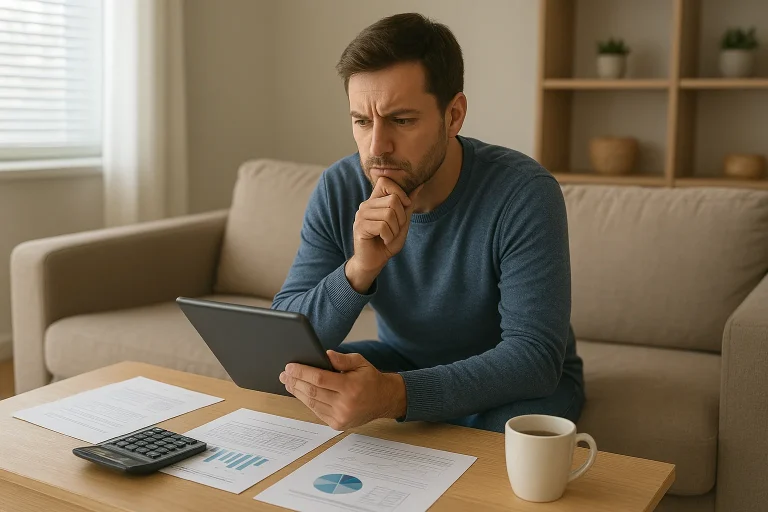In the UK, the question of how much you can earn before paying tax is a crucial one for employees, self-employed individuals, and business owners alike.
Understanding your income thresholds and tax obligations not only helps you stay compliant but also ensures you’re not paying more than necessary. With changes in tax bands, allowances, and personal thresholds, it’s more important than ever to stay up to date.
This comprehensive guide will break down the UK income tax structure for 2025/26, including the Personal Allowance, tax bands, and other factors affecting your taxable income.
Whether you’re earning a salary, working freelance, or receiving pension income, this guide will help you calculate what part of your income is tax-free and how much you owe.
What Is the Personal Allowance and How Does It Work?

The Personal Allowance is the amount of income you can earn before you are required to pay income tax in the UK. For the 2025/26 tax year, this amount remains at £12,570, applying to most individuals regardless of employment type.
This allowance is automatically applied, meaning your first £12,570 in income is tax-free. If your total income stays below this threshold for the year, you will not pay any income tax.
However, the allowance is subject to specific conditions:
- High earners with an income exceeding £100,000 see a gradual reduction in their allowance.
- Once income reaches £125,140, the Personal Allowance is fully withdrawn.
- Eligible individuals may increase their tax-free income through Blind Person’s Allowance or Marriage Allowance.
It’s also important to understand that your Personal Allowance may change mid-year if your circumstances shift significantly (e.g., receiving a large bonus, change in employment status, or taxable benefits).
How Are Income Tax Rates Structured in the UK for 2025/26?
The UK uses a progressive tax structure, meaning your income is taxed in segments based on thresholds. This tiered system ensures that only income within each tax band is taxed at that band’s rate, not your entire earnings.
Here is a breakdown of the income tax bands for the 2025/26 tax year in England, Wales, and Northern Ireland:
| Tax Band | Taxable Income Range | Tax Rate |
|---|---|---|
| Personal Allowance | Up to £12,570 | 0% |
| Basic Rate | £12,571 – £50,270 | 20% |
| Higher Rate | £50,271 – £125,140 | 40% |
| Additional Rate | Over £125,140 | 45% |
Scottish taxpayers have a different set of tax bands and rates, managed by the Scottish Government.
This structure encourages upward income mobility while ensuring higher earners contribute proportionally more in taxes. It’s important to remember that income tax applies to various income sources, not just wages, such as rental income, dividends, and pensions.
At What Point Do You Start Paying Income Tax?

You begin paying income tax once your total annual income surpasses the Personal Allowance of £12,570. Any income above this level is subject to taxation, with the rate depending on how much further it extends into the tax bands.
Let’s look at a real-world example for clarity:
Example 1
Jane works in London and earns £28,000 annually.
- Her first £12,570 is tax-free.
- The remaining £15,430 is taxed at 20%, resulting in a tax bill of £3,086.
- Jane does not cross into the higher-rate band, so she pays only the basic rate.
This tiered system means that tax increases only on the portion of income within each band. You won’t lose the benefit of lower tax rates on the first part of your income just because your earnings increase.
What Happens If You Earn Over £100,000 in the UK?
Crossing the £100,000 income threshold has unique tax implications. One of the most significant effects is the gradual removal of your Personal Allowance.
For every £2 you earn above £100,000, you lose £1 of your Personal Allowance. This tapering effect means that by the time your income reaches £125,140, your allowance is completely withdrawn.
This creates a marginal effective tax rate of 60% on earnings between £100,000 and £125,140 due to losing the tax-free buffer and entering the higher tax band simultaneously.
Example 2
David earns £110,000 per year.
- He loses £5,000 of his Personal Allowance.
- Instead of £12,570, his tax-free income becomes £7,570.
- This results in a larger taxable income and an increased tax bill compared to someone earning just below the threshold.
For high earners, pension contributions or charitable donations can reduce adjusted net income and preserve some or all of their Personal Allowance.
How Do Tax-Free Allowances Affect What You Owe?
Aside from the standard Personal Allowance, several other tax-free allowances impact how much of your income is taxable. These allowances apply to specific types of income and are designed to encourage saving and small-scale business activity.
| Allowance | Amount (2025/26) | Applies To |
|---|---|---|
| Personal Savings Allowance | £1,000 (basic rate) | Interest from savings accounts |
| Dividend Allowance | £500 | Dividends from shares |
| Trading Allowance | £1,000 | Income from self-employment or side jobs |
| Property Income Allowance | £1,000 | Rental income (non-Rent a Room Scheme) |
These allowances stack on top of the Personal Allowance, offering further opportunities to reduce tax liability. For example, if you earn £1,000 in bank interest, you may pay no tax on that income if you’re within the basic tax band and haven’t used up your savings allowance.
These allowances are automatic in many cases, but it’s essential to report them accurately during Self Assessment to avoid miscalculations.
Are There Any Additional Allowances That Can Increase Your Tax-Free Income?

Yes, several other allowances and reliefs can help increase your tax-free earnings, especially if you’re in specific life situations or income brackets.
Marriage Allowance
This allows one spouse or civil partner (who earns less than the Personal Allowance) to transfer £1,260 of their allowance to their higher-earning partner, reducing the couple’s tax liability by up to £252 annually. It’s available if both partners were born after 6 April 1935 and meet the income criteria.
Blind Person’s Allowance
Eligible individuals receive an additional £3,070 on top of the standard Personal Allowance, giving them a total of £15,640 in tax-free earnings. This must be claimed directly through HMRC and can also be transferred to a spouse or civil partner if unused.
Trading and Property Allowances
These £1,000 tax-free thresholds apply to small-scale income from self-employment and property rental. They’re ideal for side hustles or part-time landlords who want to avoid complex tax reporting if income is modest.
These additional reliefs and thresholds are often overlooked but can significantly reduce your overall tax bill when used effectively.
How Is Income Tax Calculated for Employees and the Self-Employed?
Understanding how tax is collected based on your work status is essential. While both employees and self-employed individuals are subject to the same tax rates, the method of collection varies.
Employees and PAYE
For employees, tax is deducted automatically via the Pay As You Earn (PAYE) system. Employers apply your tax code, which incorporates your Personal Allowance, to determine how much tax is withheld from your wages each month. This system ensures regular tax payments without requiring direct action.
Your payslip will usually show:
- Tax code
- Gross and net income
- National Insurance contributions
- Pension contributions (if applicable)
Self-Assessment for the Self-Employed
Self-employed individuals must report their income and expenses via an annual Self Assessment tax return. This includes:
- Gross income from all sources
- Allowable expenses (e.g., equipment, travel, office supplies)
- Tax reliefs or deductions (e.g., pension contributions)
After calculating net profit, the applicable Personal Allowance and tax bands are applied. The remaining amount is subject to income tax and National Insurance contributions (Class 2 and Class 4).
Failure to file or pay on time can lead to penalties, so staying organised and using digital accounting tools is advisable.
What Are the Most Common Mistakes to Avoid with Income Tax?

Even well-meaning individuals can make errors in managing their income tax. The most common mistakes include:
- Missing deadlines, especially for Self Assessment (31 January)
- Incorrect tax codes leading to over or underpayment
- Failing to claim eligible allowances, such as Marriage or Blind Person’s Allowance
- Overlooking allowable expenses for self-employed income
- Not updating HMRC about income changes, especially when changing jobs or taking on freelance work
Avoiding these mistakes requires basic knowledge, good record-keeping, and timely communication with HMRC. It may be worthwhile to engage an accountant or use software like Xero or Sage if you have complex income streams.
How Can You Reduce Your Income Tax Bill Legally?
Reducing your tax burden isn’t about loopholes, it’s about using legally available strategies to reduce your taxable income.
Some of the most effective methods include:
- Pension Contributions: Contributions to private pensions receive tax relief, reducing taxable income.
- Charitable Giving: Donations made under Gift Aid can be reclaimed at the basic or higher rate.
- Spreading income: Especially for self-employed individuals, invoicing strategically across tax years can help stay within lower bands.
- Claiming all allowable expenses: Business-related costs such as tools, subscriptions, and software are often deductible.
Tax planning isn’t just for the wealthy, it’s a smart financial habit that benefits anyone with variable or growing income.
Conclusion
Understanding how much you can earn before paying tax in the UK is more than just knowing the £12,570 Personal Allowance. It involves awareness of additional allowances, tax bands, the tapering of reliefs for high earners, and the proper way to report your income based on employment status.
Whether you’re employed, self-employed, or managing multiple income sources, using the available allowances and planning wisely can help you legally minimise your tax liability.
As the UK tax system continues to evolve with digitalisation and policy updates, staying informed is your best defence against penalties, and your best tool for financial efficiency.
Frequently Asked Questions
How do student earnings affect income tax in the UK?
Students are subject to the same tax rules as everyone else. If a student earns more than £12,570 in a tax year, they will begin paying income tax, even while studying.
Is National Insurance separate from income tax?
Yes. National Insurance Contributions (NICs) are separate payments that contribute to the NHS, State Pension, and other public benefits. They’re calculated based on earnings and are paid alongside income tax.
What if I have multiple income sources, how is tax calculated?
HMRC combines all taxable income, salaries, pensions, rental income, and dividends, to calculate your total annual income and applies the relevant tax bands accordingly.
Do pensioners have to pay income tax on their pension?
Yes. If total pension income (including the State Pension and private pensions) exceeds the Personal Allowance, the excess is taxable.
Can I claim back income tax if I overpaid during the year?
Yes. Overpayments through PAYE or incorrect tax codes can be reclaimed by contacting HMRC or accessing your Personal Tax Account online.
What tools can help calculate income tax in the UK?
The GOV.UK Income Tax Calculator, as well as tools from Xero, Sage, and MoneyHelper, can help estimate how much tax you’ll pay in a given year.
How often do income tax bands change in the UK?
Tax bands and allowances are reviewed annually, typically in the Spring Budget or Autumn Statement. However, changes may not be made every year depending on economic policy.







